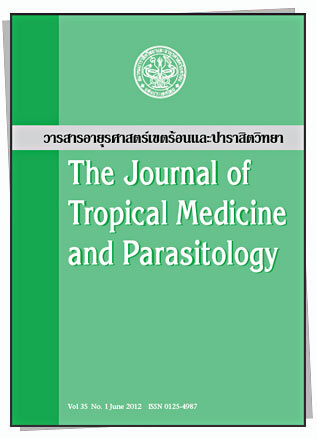Bleeding Disorder in Dengue Patients
Main Article Content
Abstract
Abstract
Dengue virus is transmitted to humans via the mosquito vector, Aedes aegypti. There are fourantigenically distinct, but closely related, serotypes of the virus (DEN-1, -2, -3, and -4), whichcause similar clinical courses and outcomes. The disease can be classified into dengue fever (DF),dengue hemorrhagic fever (DHF), and dengue shock syndrome (DSS), according to the symptomsand severity of disease. Progression to the severe degree (DHF/ DSS), characterized by bleeding andshock, and leading to high morbidity and mortality rates, can occur. Many factors contribute to aconsideration of bleeding in dengue infection, including the criteria for the grade of bleeding. Markedthrombocytopenia (platelet counts < 50 x 109/L or less) indicates clinical severity, and is associatedwith an increased incidence of spontaneous bleeding. Treatment with adequate fluid replacement isessential. The effective control of bleeding is important in the treatment of patients with DHF/DSS.Patients with bleeding receive a transfusion of platelet component to treat these complications. Thus,the decision to transfuse platelets is based on an overall assessment by the physician, clinical bleeding,and the availability of platelet component. There is limited evidence to support the propositionthat prophylactic platelet transfusion improves clinical outcomes among adult dengue patients. Inaddition, data on clinical findings, laboratory presentations, and the management of those affected,are limited. Therefore, the most important aspect of managing patients with dengue is a balance ofoptimal fluid replacement therapy and close observation to detect complications, such as bleeding.
Keywords: dengue; bleeding; platelet transfusion

